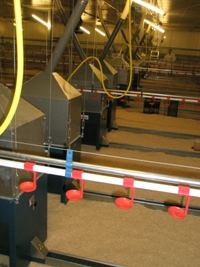Revival of the chain feeder

The popularity of chain feeder systems is growing. Through the use of new technologies and materials, various essential improvements were made possible, making the chain feeder again a labour and price competitive feeding system for all bird types.
By Wiebe van der Sluis , Rooster 45, Doetinchem, the Netherlands
More than half a century ago chain feeders were the standard feeding system in poultry. The introduction of pan feeders made many poultry producers recognise the weakness of the chain feeder and replaced it. Some of the weaknesses could be changed rather quickly, but others remained until just a few years ago. Innovations possible due to the availability of new technology and material allowed manufacturers to fight back, and with success. The chain feeder never left the poultry industry. It remained popular in cage systems and over the years it has become a preferred system in parent stock and aviary housing.
In recent years an increasing number of broiler breeder growers have shown renewed interest in the chain feeder. That interest initially came from those who prefer a simple, open and affordable system which can easily be managed and cleaned. They discovered that the historical disadvantage of being labour demanding and causing uneven flocks, due to selective feed picking along the slow moving chain, did not exist any more.
Direct drive
The modern chain feeder can be elevated as easy as any pan feeder system and is able to distribute the feed at high speed at the desired amount. VDL Agrotech, one of the leading makers of chain feeders, initiated a number of improvements in their Chainovation program. At first sight the improvements seem to be marginal, but a closer look shows why the system deserves to be reconsidered as the feed distribution system in poultry.
In the past it was rather labour intensive to adjust chain feeders to the desired height during the production cycle of pullets and broilers. At clean out the whole system had to be dismantled for cleaning and reinstalled before the new flock came in. “Fortunately this is something of the past since the whole system was taken off the ground and suspended from the ceiling so it can be winched up at the required height during production and depopulation”, says Mari Beniers, product manager with VDL when pointing at a range of new features.
He experienced that users appreciate the chain feeder because it is an open system which is easy to clean, control and maintain. “Through introducing the direct motor drive principle the system has become more compact, requires less maintenance and is more energy efficient. A 35mm axle, connecting carrier wheels by means of safety dowel pins, allows a maximum power transfer to each of the chain circuits”, Beniers adds.
Hopper extensions
Besides introducing a direct drive unit, VDL also changed the construction of the hopper. It has now a power coated welded solid and durable structure with 1,2,3 or 4 circuits pre-mounted. Each of the circuits runs in an opposite direction. The hoppers are designed for stable suspension, with a plastic flexible bag extension to connect the in-feed auger with the hopper at all heights.
“Inside the hopper one may find one of the interesting improvements,” says Beniers. “Even the most experienced poultry grower would hardly recognise it, but we know that they will be pleased with it. We have moved the return wheel further inside the hopper to minimise the loss and better mix the return feed. The wheel is made of two nylon halves and a hardened steel gear with better fixed dimensions.”
“To assure the right amount of feed distributed to the birds, the Chainovation hopper has got a slide which can easily set the feed level in seven different positions, ranging from 1125 to 3000 kg/hour during production.
Increased speed
Traditionally chain feeders were known to distribute feed at a low speed causing a lot of stress among birds. When starting the feeder the larger and most aggressive birds moved to the hopper to get a spot as close as possible to the fresh feed delivery point to get the best feed particles. Besides causing stress and dust it also allowed these assertive birds to grow faster than the less dominant ones, resulting in a flock suffering from uniformity. With troughs using high-speed chain circuits (up to 36m/min) it became feasible to eliminate this problem. It assured a fast distribution of feed and minimised the need for birds to fight for a good position along the trough. All birds get their portion of high quality feed at more or less the same time.
“Increasing line speed seemed to be a simple solution, however it required a number of changes in guiding the chain through the hopper and trough, explained Beniers. “For critical parts we had to make use of special steel to cope with the extra force and wear. Take for example the chain guide block in the hopper and the corners. They have undergone changes to assure that the chain will run smoothly and will drag the feed through the trough at the desired speed and amount”.
“Based on field results”, Beniers concludes, “we now can say that the new chain feeder can meet the demands of the modern poultry grower. The fact that many top poultry breeder farmers prefer the use of a chain feeder give us the confidence to say that this feeding system is ready for the future”.
| Through introducing the direct motor drive principle the system has become more compact, requiring less maintenance and is more energy efficient. | The entire system, including hoppers is suspended and can easily be winched. | Breeder farmers tend to prefer the use of a chain feeder which indicates that this traditional feeding system is ready for its comeback. |












